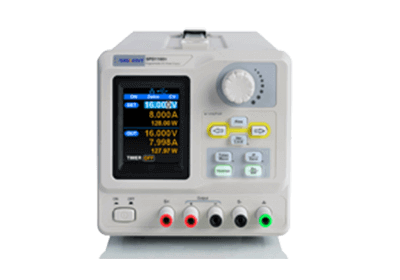What Is Programmable Power Supply?

A Programmable Power Supply is a power supply with an output that can be varied as desired.
General power supplies allow manual adjustment of output voltage and current settings. Programmable power supplies, however, are characterized by the ability to freely set output voltage, current, and frequency using commands from a controller.
Uses of Programmable Power Supplies
Programmable power supplies are used for testing the characteristics of semiconductor devices and other electronic equipment. They are useful for automatically acquiring data or for investigating the response of a measurement object by gradually changing power supply conditions.
Particularly for applications that measure the voltage-current characteristics of semiconductors, there are dedicated measurement devices that house a high-precision Programmable Power Supply and a voltage-current measurement device in the same housing, which is controlled by a controller.
Recently, a product combining a large-capacity Programmable Power Supply and a measurement unit capable of evaluating power semiconductors has also been introduced.
Programmable Power Supplies are also being used in a wide range of other fields, from home appliances to aerospace, military, power generation, renewable energy, and more.
Principle of Programmable Power Supplies
Basically, Programmable Power Supplies are a type of regulated power supply in which a reference voltage is set by a D/A converter and the corresponding voltage or current is output. When connected to a controller, the controller can change the output voltage/current by rewriting the data in the D/A converter.
Types of Programmable Power Supply
Classified by power supply circuit configuration, the following types are available:
1. Dropper Type DC Power Supply
A DC power supply, also known as a linear power supply or series power supply, is characterized by its low output voltage noise.
They are mainly used in measurements where noise should be minimized, such as when handling minute signals. However, their power conversion efficiency is generally low and they generate a lot of heat, so heat dissipation measures are necessary.
The output voltage is compared with a reference voltage and is feedback controlled to always be a constant voltage.
2. Switching Type DC Power Supply
Compared to the dropper type, the switching type DC power supply is more efficient and is currently the mainstream power supply. Although it is somewhat noisier, it generates less heat and can produce a large-capacity power supply, so it is also used in testing equipment that requires a large current, such as hybrid vehicles.
As with the dropper method, the output voltage is compared to a reference voltage and feedback control is performed to ensure that the voltage is always constant.
3. High Voltage Power Supply
While the output voltage range of a typical Programmable Power Supply is in the tens of volts, there are power supplies that specialize in high-voltage output.
High-voltage Programmable Power Supplies, which can generate thousands to tens of thousands of volts DC, are used in the following applications:
- Photomultiplier tubes
- Mass spectrometers
- Electron beam control
- Photoconductor drum charging in photocopiers, etc.
However, they are rarely used alone and are often integrated into systems as part of the equipment.
4. Bipolar Power Supply
Bipolar power supplies are capable of outputting not only direct current but also alternating current, and have a sink function as well as a source function for electric power. As a circuit configuration, it is a kind of power amplifier and can be used not only as a power source but also as an electronic load.
Because it is a power amplifier circuit, it can output AC power at relatively high frequencies, and in combination with a controller or signal generator, it can generate complex test waveforms. This is also used to measure power supply voltage fluctuation characteristics in various electronic devices and for driving tests of piezoelectric elements.
5. Voltage/Current Generator for Calibration
Voltage/current generators used as reference signals for calibration/inspection of digital multimeters that measure voltage and current, and various equipment on production lines are also part of Programmable Power Supplies.
Unlike ordinary power supplies, they require high precision in output voltage and current values, but the amount of power that can be output is not so critical.
The use of programmable power supplies in combination with controllers is possible, for example, to automatically acquire calibration data.